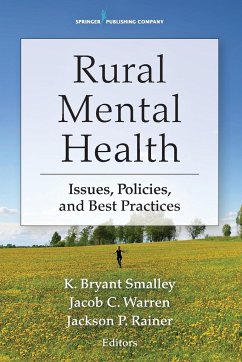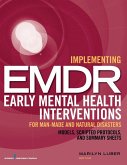Rural Mental Health
Issues, Policies, and Best Practices
Herausgeber: Smalley, K. Bryant PsyD MBA; Rainer, Jackson P.; Warren, Jacob C. MBA CRA
Rural Mental Health
Issues, Policies, and Best Practices
Herausgeber: Smalley, K. Bryant PsyD MBA; Rainer, Jackson P.; Warren, Jacob C. MBA CRA
- Broschiertes Buch
- Merkliste
- Auf die Merkliste
- Bewerten Bewerten
- Teilen
- Produkt teilen
- Produkterinnerung
- Produkterinnerung
Named a 2013 Doody's Core Title! Addressing the needs of America's most underserved areas for mental health services, Rural Mental Health offers the most up-to-date, research-based information on policies and practice in rural and frontier populations. Eminent clinicians and researchers examine the complexities of improving mental health in rural practice and offer clear recommendations which can be adapted into current practice and training programs. They bring an incisive lens to factors that contribute to mental illness and prevent access to treatment areas. These include limited resources,…mehr
![Rural Rhymes, Illustrative of Rustic Customs and Popular Superstitions Rural Rhymes, Illustrative of Rustic Customs and Popular Superstitions]() G. T. ManningRural Rhymes, Illustrative of Rustic Customs and Popular Superstitions33,99 €
G. T. ManningRural Rhymes, Illustrative of Rustic Customs and Popular Superstitions33,99 €![A Handbook for the Study of Mental Health A Handbook for the Study of Mental Health]() A Handbook for the Study of Mental Health144,99 €
A Handbook for the Study of Mental Health144,99 €![Normality Does Not Equal Mental Health Normality Does Not Equal Mental Health]() Steven BartlettNormality Does Not Equal Mental Health73,99 €
Steven BartlettNormality Does Not Equal Mental Health73,99 €![Implementing EMDR Early Mental Health Interventions for Man-Made and Natural Disasters Implementing EMDR Early Mental Health Interventions for Man-Made and Natural Disasters]() Implementing EMDR Early Mental Health Interventions for Man-Made and Natural Disasters91,99 €
Implementing EMDR Early Mental Health Interventions for Man-Made and Natural Disasters91,99 €![A Manifesto for Mental Health A Manifesto for Mental Health]() Peter KindermanA Manifesto for Mental Health22,99 €
Peter KindermanA Manifesto for Mental Health22,99 €![All My Mental Health Shit All My Mental Health Shit]() Amy NewtonAll My Mental Health Shit22,99 €
Amy NewtonAll My Mental Health Shit22,99 €![PSYCHOSOCIAL PROTECTIVE AND RISK FACTORS AT WORK AND MENTAL HEALTH PSYCHOSOCIAL PROTECTIVE AND RISK FACTORS AT WORK AND MENTAL HEALTH]() Milena SilvaPSYCHOSOCIAL PROTECTIVE AND RISK FACTORS AT WORK AND MENTAL HEALTH35,99 €
Milena SilvaPSYCHOSOCIAL PROTECTIVE AND RISK FACTORS AT WORK AND MENTAL HEALTH35,99 €-
-
-
Hinweis: Dieser Artikel kann nur an eine deutsche Lieferadresse ausgeliefert werden.
- Produktdetails
- Verlag: Springer Publishing Company
- Seitenzahl: 386
- Erscheinungstermin: 1. Juni 2012
- Englisch
- Abmessung: 229mm x 152mm x 21mm
- Gewicht: 558g
- ISBN-13: 9780826107992
- ISBN-10: 0826107990
- Artikelnr.: 34228847
- Herstellerkennzeichnung
- Books on Demand GmbH
- In de Tarpen 42
- 22848 Norderstedt
- info@bod.de
- 040 53433511
- Verlag: Springer Publishing Company
- Seitenzahl: 386
- Erscheinungstermin: 1. Juni 2012
- Englisch
- Abmessung: 229mm x 152mm x 21mm
- Gewicht: 558g
- ISBN-13: 9780826107992
- ISBN-10: 0826107990
- Artikelnr.: 34228847
- Herstellerkennzeichnung
- Books on Demand GmbH
- In de Tarpen 42
- 22848 Norderstedt
- info@bod.de
- 040 53433511
1. The Current State of Rural Mental Health (K. Bryant Smalley, Ph.D.,
Psy.D. & Jacob C. Warren, Ph.D.)
a. Introduction
b. What is Rural?
c. Mental Health in Rural Areas
d. Addressing Core Problems in Rural Mental Health
e. Conclusion
f. References
2. Advancing Federal Policies in Rural Mental Health (Patrick H. DeLeon,
Ph.D., J.D., M.P.H., Mary Beth Kenkel, Ph.D. & Diana V. Shaw, Ph.D.,
M.P.H., M.B.A., F.A.C.M.P.E.)
a. Introduction
b. Three Historical Views of Rural Mental Health that Shaped Policy
Directions
c. The Importance of Personal Involvement in Advocacy and Long Term Vision
for Mental Health Providers in Rural Areas
i. Opportunities for Involvement in Rural Mental Health Advocacy
d. Recruiting and Retaining Rural Mental Health Workers
e. The Patient Protection and Affordable Care Act (PPACA)
f. Technology Effectively Addressing the Impact of Historical Isolation
g. The Advent of Telepsychology and Licensure Mobility
h. Conclusion
i. References
3. Rurality as a Diversity Issue (K. Bryant Smalley, Ph.D., Psy.D. & Jacob
C. Warren, Ph.D.)
a. Introduction: The Importance of Culture in Mental Health
b. What about Rural?
c. The Culture of Rural Living
i. Remoteness and Isolation
ii. Agriculture
iii. Poverty
iv. Religion
v. Behavioral Norms
vi. Stigma
d. Implications for Training Programs
e. Implications for Practicing Therapists
f. Conclusion
g. References
4. The Impact of Mental Health Stigma on Clients from Rural Settings
(Jonathon E. Larson, Ed.D., M.S., L.C.P.C., C.R.C., Patrick W Corrigan,
Psy.D. & Thomas P. Cothran)
a. Introduction
b. Public Stigma
c. Self-Stigma
d. Stigma in Rural Settings
e. Treatment of Self-Stigma in Rural Settings
i. Case Illustration
1. Presenting Problem and Client Description
2. Case Formulation
3. Course of Treatment
f. Conclusion
g. References
5. Loneliness and Isolation in Rural Areas (Jackson P. Rainer, Ph.D.,
A.B.P.P. & Johnathan C. Martin, Ed.S.)
a. Introduction
b. Loneliness as a Psychotherapy Issue
c. When Loneliness Becomes a Problem
d. Isolation and the Pain of Yearning
e. The Treatment of Loneliness and Isolation
f. Conclusion
g. References
6. Religion and Rural Mental Health (Jamie Aten, Ph.D., Patrick Hall,
M.Div., Isaac Weaver, Michael Mangis, Ph.D., & Clark Campbell, Ph.D.,
A.B.P.P.)
a. Introduction
b. Religion
c. Impact of Religion on Well-Being
d. Role and Influence of Religion in Rural Communities
e. The Role of the Church in the Rural Community
f. Rural Religious Worldviews
i. Amish Religious Worldview
ii. Appalachian and Serpent-Handling Religious Worldviews
g. Mental Health Care in the Rural Context
h. Mental Health Care with Rural Religious Clients
i. Conclusion
j. References
7. Ethical and Professional Challenges of Mental Healthcare Delivery in
Rural Communities (James L. Werth, Jr., Ph.D., A.B.P.P.)
a. Introduction
b. A Day in the Life of a Small Town Psychotherapist
c. Major Ethical Issues and Professional Challenges in Rural Areas
i. Incidental Encounters
ii. Visibility of the Therapist
iii. Multiple Relationships
1. Current Clients
2. Former Clients
3. Among Current/Former Clients
4. Among the Therapist's Significant Others and Current/Former Clients or
Significant Others of Current/Former Clients
5. Among Staff/Consultants and Clients/Former Clients
6. The Special Case of Barter
iv. Confidentiality
v. Competence
1. Clinical Competence
2. Assessment Competence
3. Expansion of Responsibilities because of Lack of Available Referral
Options
d. Recommendations for Practice in Rural Areas
e. References
8. Rural Mental Health Practitioners: Their Own Mental Health Needs (David
S. Hargrove, Ph.D., A.B.P.P. & Lisa Curtin, Ph.D.)
a. Introduction
b. Provider Distress, Impairment, and Burnout
c. Prevention, Detection, and Intervention: Importance of Self-Care
d. Bowen Family Systems Theory
e. Case Study
i. Background
ii. Interpretation of Case Study
f. Conclusion
g. References
SECTION TWO - MODELS OF SERVICE DELIVERY
9. Integrated Care in Rural Areas (David Lambert, Ph.D. & John Gale, M.S.)
a. Introduction
b. Background
i. Definition of Integration
ii. Models of Integration
iii. Barriers to Integration
iv. Evidence for Integration
c. Integrated Care in Rural Areas
d. Current and Best Practices in Rural Integration
e. Case Studies of Integrated Care in Rural Communities
f. Rural Integration in a Changing Policy Environment: The Road Ahead
i. State Fiscal Pressures
ii. The Road Ahead
g. Practical Steps to Getting Started
h. References
10. Technological Innovations in Rural Mental Health Service Delivery
(Sarah Velasquez, M.A.B., M.S., Angela Bannitt Duncan, M.A. & Eve-Lynn
Nelson, Ph.D.)
a. Introduction
b. Telephone
c. Televideo Interventions
d. Mobile Interventions
e. Computer-Based Technologies
i. Computer-Based Assessment
ii. Computer-Based Therapy
f. Social Media Tools
g. Technology Implementation with Mental Health Interventions
h. Conclusion
i. References
11. School and Home-Based Interventions in Rural Communities (Angela M.
Waguespack, Ph.D., Carmen Broussard, Ph.D. & Kristin Guilfou)
a. Introduction
b. The School as the Hub of Service Delivery
c. Use of Problem-Solving and a Multitiered System of Service Delivery
i. Tier 1: Universal
ii. Tier 2: Selected or Targeted Support
iii. Tier 3: Targeted, Intensive
d. Incorporating an Ecological Perspective
i. Family School Partnerships
ii. Interagency Collaboration
e. Case Example
i. History and Background
ii. Universal Interventions (Tier 1)
1. Partnering with Families
2. School-Wide Positive Behavioral Interventions and Supports (PBiS)
3. Monitoring of Behavioral and Academic Progress
4. Tier 1 Results
iii. Strategic Interventions (Tier 2)
1. Problem-Solving Committee (PSC)
2. Tier 2 Results
iv. Intensive Interventions (Tier 3)
1. Problem-Solving Committee (PSC)
2. Tier 3 Results
v. Case Summary and Suggested Improvements
1. Tier 1
2. Tier 2
3. Tier 3
f. Conclusion
g. References
SECTION THREE - WORKING WITH SPECIFIC POPULATIONS AND ISSUES
12. Substance Use and Abuse in Rural America (Jennifer D. Lenardson,
M.H.S., David Hartley, Ph.D., M.H.A., John A Gale, M.S. & Karen B. Pearson,
M.L.I.S., M.A.)
a. Introduction
b. Prevalence of Rural Substance Use and Abuse
i. Patterns of Substance Use
ii. Patterns of Substance Abuse by Demographic and Socioeconomic
Characteristics
iii. Specific Substance Use Issues in Rural Communities
c. Prevention
i. Review of Prevention Theory and Practice
ii. Applying Theory and Practice to Rural Populations
d. Substance Abuse Treatment
i. Distribution and Characteristics of Rural Providers
ii. Lack of Intensive Services and Special Programs
iii. Challenges to Treatment Accessibility
iv. Treatment Models with Relevance for Rural Providers
1. Role of Primary Care in Identifying and Treating Substance Abuse
2. Telehealth
3. Residential Service Options
e. Continuing Care and Long Term Support
f. Conclusion
g. References
13. Suicide in Rural Areas: Risk Factors and Prevention (Courtney Cantrell,
M.S., Sarah Valley-Gray, Psy.D. & Ralph E. Cash, Ph.D., N.C.S.P.)
a. Introduction
b. Risk Factors for Suicide in Rural Areas
i. Access to Lethal Means
ii. Geographic and Social Isolation
iii. Culture of the Community
iv. Stigma
c. Suicide in Rural Areas: Prevention, Intervention, and Systems of Care
i. Prevention
ii. Intervention
iii. Systems of Care
d. References
14. Providing Mental Health Services for Racial, Ethnic, and Sexual
Orientation Minority Groups in Rural Areas (Ishan Williams, Ph.D., Derick
Williams, Ph.D., Amanda Pellegrino, Psy.S. & Jacob C. Warren, Ph.D.)
a. Introduction
b. Racial and Ethnic Disparities in Rural Areas
i. Barriers to Provision of Mental Health Services for Rural Minorities
c. The Impact of Sexual Orientation on Mental Health in Rural Areas
i. Heterosexism
ii. Invisibility and "Don't Ask, Don't Tell"
iii. Victimization and Discrimination
iv. Isolation
v. Lack of Support
vi. Mental Health Providers and Services
d. A Holistic Approach to Mental Health for Rural Minorities
i. The Indivisible Self Wellness Model
e. Implications for Best Practices and Recommendations for the Future
i. Racial and Ethnic Minorities
ii. Sexual Orientation
f. Conclusion
g. References
15. Providing Mental Health Services for Women in Rural Areas (Frieda
Farfour Brown, Ph.D., Shannon P. Warden, Ph.D., L.P.C., N.C.C. & Amanda
Brown Kotis, M.A., D.M.D.)
a. Introduction
b. The Biopsychosocial Model
c. Collaboration between Primary Care Providers and Psychologists
d. Collaboration between Religious Organizations and Mental Health
Professionals
e. Collaboration with Community-Based Programs: Case Examples
f. Collaboration with University Training Programs
g. Conclusion
h. References
16. Providing Mental Health Services for Men in Rural Areas (Don Gorman,
R.N., Dip.N.Ed., B.Ed., M.Ed., Ed.D., F.R.C.N.A., F.A.C.M.H.N., Robert
Eley, Ph.D. & Delwar Hossain, Ph.D.)
a. Introduction
b. Characteristics of Rural Men
c. Health-Related Behavior
d. Stigma of Mental Illness
e. Suicides in Rural and Remote Communities
f. Provision of Health Services to Rural Men
g. What Works: Steps That Can Be Taken to Address the Needs of Rural Men
h. Community Capacity Building
i. Conclusion
j. References
17. Providing Mental Health Services for Children, Adolescents, and
Families in Rural Areas (Heidi Liss Radunovich, Ph.D. & Brenda A. Wiens,
Ph.D.)
a. Introduction
b. Need for Mental Health Care Among Rural Children, Adolescents, and
Families
c. Challenging Issues and Barriers to Care for Rural Children, Adolescents,
and Families
i. Lack of Providers
ii. Distance
iii. Financial Issues
iv. Confidentiality and Ethical Practice Concerns
v. Stigma and Perceptions of Therapy
d. Potential Solutions for Increasing Service Provision
i. Use of Technology for Service Provision
ii. School-Based Care and Coordinated Community Response
1. Case Example: Project CATCh
2. Community-Based Participatory Collaboration
iii. Prevention-Based Focus
e. Conclusion
f. References
18. Providing Mental Health Services for Older Adults and Caregivers in
Rural Areas (Martha R. Crowther, Ph.D., M.P.H., Forrest Scogin, Ph.D.,
Ernest Wayde, M.A. & Audrey Austin, M.P.H., M.A.)
a. Introduction
b. Older, Rural Adults
c. Mental Health and Rural Elders
d. Family Caregiving and Rural Elders
e. Adapting CBT for Treating the Rural Elderly
f. Using CBT for Treating Depression in the Rural Elderly
g. Case Illustration
i. Presenting Problem and Client Description
ii. Case Formulation
iii. Course of Treatment
h. Clinical Practices and Conclusion
i. References
19. Providing Mental Health Services for Rural Veterans (John Paul Jameson,
Ph.D. & Lisa Curtin, Ph.D.)
a. Introduction
b. Characteristics of Rural Veterans
c. Barriers to Care for Rural Veterans
d. Working with Rural Veterans: Practice Issues
e. Future Directions for Research and Practice
f. References
20. Working in Frontier Communities (Jaedon P. Avey, M.S., Mimi McFaul,
Psy.D., Tamara L. DeHay, Ph.D. & Dennis Mohatt, M.A.)
a. Introduction
b. Challenges and Adaptations
i. Developing Relationships
ii. Community Self-Determination and Co-Participation
iii. Boundaries and Ethics
c. Rural Lifestyle and Self-Care
d. Workforce Recruitment and Retention
e. Rewards of Working in a Frontier Setting
f. Experiential Lessons Learned
i. Logistics
ii. Presence
iii. Awareness of Self
iv. Awareness of Community
v. Self-Presentation
vi. Professional Relationships and Collaboration
vii. Self-Care and Safety
g. Conclusion
h. References
SECTION FOUR - LOOKING TO THE FUTURE
21. Rural Mental Health: Future Directions and Recommendations (K. Bryant
Smalley, Ph.D., Psy.D. & Jacob C. Warren, Ph.D.)
a. Introduction
b. Improving Availability of Services
c. Increasing Accessibility of Care
d. Improving Acceptability of Mental Health Services
e. Evidence-Base for Rural Practice
f. The Importance of Advocacy
g. Conclusion
h. References
1. The Current State of Rural Mental Health (K. Bryant Smalley, Ph.D.,
Psy.D. & Jacob C. Warren, Ph.D.)
a. Introduction
b. What is Rural?
c. Mental Health in Rural Areas
d. Addressing Core Problems in Rural Mental Health
e. Conclusion
f. References
2. Advancing Federal Policies in Rural Mental Health (Patrick H. DeLeon,
Ph.D., J.D., M.P.H., Mary Beth Kenkel, Ph.D. & Diana V. Shaw, Ph.D.,
M.P.H., M.B.A., F.A.C.M.P.E.)
a. Introduction
b. Three Historical Views of Rural Mental Health that Shaped Policy
Directions
c. The Importance of Personal Involvement in Advocacy and Long Term Vision
for Mental Health Providers in Rural Areas
i. Opportunities for Involvement in Rural Mental Health Advocacy
d. Recruiting and Retaining Rural Mental Health Workers
e. The Patient Protection and Affordable Care Act (PPACA)
f. Technology Effectively Addressing the Impact of Historical Isolation
g. The Advent of Telepsychology and Licensure Mobility
h. Conclusion
i. References
3. Rurality as a Diversity Issue (K. Bryant Smalley, Ph.D., Psy.D. & Jacob
C. Warren, Ph.D.)
a. Introduction: The Importance of Culture in Mental Health
b. What about Rural?
c. The Culture of Rural Living
i. Remoteness and Isolation
ii. Agriculture
iii. Poverty
iv. Religion
v. Behavioral Norms
vi. Stigma
d. Implications for Training Programs
e. Implications for Practicing Therapists
f. Conclusion
g. References
4. The Impact of Mental Health Stigma on Clients from Rural Settings
(Jonathon E. Larson, Ed.D., M.S., L.C.P.C., C.R.C., Patrick W Corrigan,
Psy.D. & Thomas P. Cothran)
a. Introduction
b. Public Stigma
c. Self-Stigma
d. Stigma in Rural Settings
e. Treatment of Self-Stigma in Rural Settings
i. Case Illustration
1. Presenting Problem and Client Description
2. Case Formulation
3. Course of Treatment
f. Conclusion
g. References
5. Loneliness and Isolation in Rural Areas (Jackson P. Rainer, Ph.D.,
A.B.P.P. & Johnathan C. Martin, Ed.S.)
a. Introduction
b. Loneliness as a Psychotherapy Issue
c. When Loneliness Becomes a Problem
d. Isolation and the Pain of Yearning
e. The Treatment of Loneliness and Isolation
f. Conclusion
g. References
6. Religion and Rural Mental Health (Jamie Aten, Ph.D., Patrick Hall,
M.Div., Isaac Weaver, Michael Mangis, Ph.D., & Clark Campbell, Ph.D.,
A.B.P.P.)
a. Introduction
b. Religion
c. Impact of Religion on Well-Being
d. Role and Influence of Religion in Rural Communities
e. The Role of the Church in the Rural Community
f. Rural Religious Worldviews
i. Amish Religious Worldview
ii. Appalachian and Serpent-Handling Religious Worldviews
g. Mental Health Care in the Rural Context
h. Mental Health Care with Rural Religious Clients
i. Conclusion
j. References
7. Ethical and Professional Challenges of Mental Healthcare Delivery in
Rural Communities (James L. Werth, Jr., Ph.D., A.B.P.P.)
a. Introduction
b. A Day in the Life of a Small Town Psychotherapist
c. Major Ethical Issues and Professional Challenges in Rural Areas
i. Incidental Encounters
ii. Visibility of the Therapist
iii. Multiple Relationships
1. Current Clients
2. Former Clients
3. Among Current/Former Clients
4. Among the Therapist's Significant Others and Current/Former Clients or
Significant Others of Current/Former Clients
5. Among Staff/Consultants and Clients/Former Clients
6. The Special Case of Barter
iv. Confidentiality
v. Competence
1. Clinical Competence
2. Assessment Competence
3. Expansion of Responsibilities because of Lack of Available Referral
Options
d. Recommendations for Practice in Rural Areas
e. References
8. Rural Mental Health Practitioners: Their Own Mental Health Needs (David
S. Hargrove, Ph.D., A.B.P.P. & Lisa Curtin, Ph.D.)
a. Introduction
b. Provider Distress, Impairment, and Burnout
c. Prevention, Detection, and Intervention: Importance of Self-Care
d. Bowen Family Systems Theory
e. Case Study
i. Background
ii. Interpretation of Case Study
f. Conclusion
g. References
SECTION TWO - MODELS OF SERVICE DELIVERY
9. Integrated Care in Rural Areas (David Lambert, Ph.D. & John Gale, M.S.)
a. Introduction
b. Background
i. Definition of Integration
ii. Models of Integration
iii. Barriers to Integration
iv. Evidence for Integration
c. Integrated Care in Rural Areas
d. Current and Best Practices in Rural Integration
e. Case Studies of Integrated Care in Rural Communities
f. Rural Integration in a Changing Policy Environment: The Road Ahead
i. State Fiscal Pressures
ii. The Road Ahead
g. Practical Steps to Getting Started
h. References
10. Technological Innovations in Rural Mental Health Service Delivery
(Sarah Velasquez, M.A.B., M.S., Angela Bannitt Duncan, M.A. & Eve-Lynn
Nelson, Ph.D.)
a. Introduction
b. Telephone
c. Televideo Interventions
d. Mobile Interventions
e. Computer-Based Technologies
i. Computer-Based Assessment
ii. Computer-Based Therapy
f. Social Media Tools
g. Technology Implementation with Mental Health Interventions
h. Conclusion
i. References
11. School and Home-Based Interventions in Rural Communities (Angela M.
Waguespack, Ph.D., Carmen Broussard, Ph.D. & Kristin Guilfou)
a. Introduction
b. The School as the Hub of Service Delivery
c. Use of Problem-Solving and a Multitiered System of Service Delivery
i. Tier 1: Universal
ii. Tier 2: Selected or Targeted Support
iii. Tier 3: Targeted, Intensive
d. Incorporating an Ecological Perspective
i. Family School Partnerships
ii. Interagency Collaboration
e. Case Example
i. History and Background
ii. Universal Interventions (Tier 1)
1. Partnering with Families
2. School-Wide Positive Behavioral Interventions and Supports (PBiS)
3. Monitoring of Behavioral and Academic Progress
4. Tier 1 Results
iii. Strategic Interventions (Tier 2)
1. Problem-Solving Committee (PSC)
2. Tier 2 Results
iv. Intensive Interventions (Tier 3)
1. Problem-Solving Committee (PSC)
2. Tier 3 Results
v. Case Summary and Suggested Improvements
1. Tier 1
2. Tier 2
3. Tier 3
f. Conclusion
g. References
SECTION THREE - WORKING WITH SPECIFIC POPULATIONS AND ISSUES
12. Substance Use and Abuse in Rural America (Jennifer D. Lenardson,
M.H.S., David Hartley, Ph.D., M.H.A., John A Gale, M.S. & Karen B. Pearson,
M.L.I.S., M.A.)
a. Introduction
b. Prevalence of Rural Substance Use and Abuse
i. Patterns of Substance Use
ii. Patterns of Substance Abuse by Demographic and Socioeconomic
Characteristics
iii. Specific Substance Use Issues in Rural Communities
c. Prevention
i. Review of Prevention Theory and Practice
ii. Applying Theory and Practice to Rural Populations
d. Substance Abuse Treatment
i. Distribution and Characteristics of Rural Providers
ii. Lack of Intensive Services and Special Programs
iii. Challenges to Treatment Accessibility
iv. Treatment Models with Relevance for Rural Providers
1. Role of Primary Care in Identifying and Treating Substance Abuse
2. Telehealth
3. Residential Service Options
e. Continuing Care and Long Term Support
f. Conclusion
g. References
13. Suicide in Rural Areas: Risk Factors and Prevention (Courtney Cantrell,
M.S., Sarah Valley-Gray, Psy.D. & Ralph E. Cash, Ph.D., N.C.S.P.)
a. Introduction
b. Risk Factors for Suicide in Rural Areas
i. Access to Lethal Means
ii. Geographic and Social Isolation
iii. Culture of the Community
iv. Stigma
c. Suicide in Rural Areas: Prevention, Intervention, and Systems of Care
i. Prevention
ii. Intervention
iii. Systems of Care
d. References
14. Providing Mental Health Services for Racial, Ethnic, and Sexual
Orientation Minority Groups in Rural Areas (Ishan Williams, Ph.D., Derick
Williams, Ph.D., Amanda Pellegrino, Psy.S. & Jacob C. Warren, Ph.D.)
a. Introduction
b. Racial and Ethnic Disparities in Rural Areas
i. Barriers to Provision of Mental Health Services for Rural Minorities
c. The Impact of Sexual Orientation on Mental Health in Rural Areas
i. Heterosexism
ii. Invisibility and "Don't Ask, Don't Tell"
iii. Victimization and Discrimination
iv. Isolation
v. Lack of Support
vi. Mental Health Providers and Services
d. A Holistic Approach to Mental Health for Rural Minorities
i. The Indivisible Self Wellness Model
e. Implications for Best Practices and Recommendations for the Future
i. Racial and Ethnic Minorities
ii. Sexual Orientation
f. Conclusion
g. References
15. Providing Mental Health Services for Women in Rural Areas (Frieda
Farfour Brown, Ph.D., Shannon P. Warden, Ph.D., L.P.C., N.C.C. & Amanda
Brown Kotis, M.A., D.M.D.)
a. Introduction
b. The Biopsychosocial Model
c. Collaboration between Primary Care Providers and Psychologists
d. Collaboration between Religious Organizations and Mental Health
Professionals
e. Collaboration with Community-Based Programs: Case Examples
f. Collaboration with University Training Programs
g. Conclusion
h. References
16. Providing Mental Health Services for Men in Rural Areas (Don Gorman,
R.N., Dip.N.Ed., B.Ed., M.Ed., Ed.D., F.R.C.N.A., F.A.C.M.H.N., Robert
Eley, Ph.D. & Delwar Hossain, Ph.D.)
a. Introduction
b. Characteristics of Rural Men
c. Health-Related Behavior
d. Stigma of Mental Illness
e. Suicides in Rural and Remote Communities
f. Provision of Health Services to Rural Men
g. What Works: Steps That Can Be Taken to Address the Needs of Rural Men
h. Community Capacity Building
i. Conclusion
j. References
17. Providing Mental Health Services for Children, Adolescents, and
Families in Rural Areas (Heidi Liss Radunovich, Ph.D. & Brenda A. Wiens,
Ph.D.)
a. Introduction
b. Need for Mental Health Care Among Rural Children, Adolescents, and
Families
c. Challenging Issues and Barriers to Care for Rural Children, Adolescents,
and Families
i. Lack of Providers
ii. Distance
iii. Financial Issues
iv. Confidentiality and Ethical Practice Concerns
v. Stigma and Perceptions of Therapy
d. Potential Solutions for Increasing Service Provision
i. Use of Technology for Service Provision
ii. School-Based Care and Coordinated Community Response
1. Case Example: Project CATCh
2. Community-Based Participatory Collaboration
iii. Prevention-Based Focus
e. Conclusion
f. References
18. Providing Mental Health Services for Older Adults and Caregivers in
Rural Areas (Martha R. Crowther, Ph.D., M.P.H., Forrest Scogin, Ph.D.,
Ernest Wayde, M.A. & Audrey Austin, M.P.H., M.A.)
a. Introduction
b. Older, Rural Adults
c. Mental Health and Rural Elders
d. Family Caregiving and Rural Elders
e. Adapting CBT for Treating the Rural Elderly
f. Using CBT for Treating Depression in the Rural Elderly
g. Case Illustration
i. Presenting Problem and Client Description
ii. Case Formulation
iii. Course of Treatment
h. Clinical Practices and Conclusion
i. References
19. Providing Mental Health Services for Rural Veterans (John Paul Jameson,
Ph.D. & Lisa Curtin, Ph.D.)
a. Introduction
b. Characteristics of Rural Veterans
c. Barriers to Care for Rural Veterans
d. Working with Rural Veterans: Practice Issues
e. Future Directions for Research and Practice
f. References
20. Working in Frontier Communities (Jaedon P. Avey, M.S., Mimi McFaul,
Psy.D., Tamara L. DeHay, Ph.D. & Dennis Mohatt, M.A.)
a. Introduction
b. Challenges and Adaptations
i. Developing Relationships
ii. Community Self-Determination and Co-Participation
iii. Boundaries and Ethics
c. Rural Lifestyle and Self-Care
d. Workforce Recruitment and Retention
e. Rewards of Working in a Frontier Setting
f. Experiential Lessons Learned
i. Logistics
ii. Presence
iii. Awareness of Self
iv. Awareness of Community
v. Self-Presentation
vi. Professional Relationships and Collaboration
vii. Self-Care and Safety
g. Conclusion
h. References
SECTION FOUR - LOOKING TO THE FUTURE
21. Rural Mental Health: Future Directions and Recommendations (K. Bryant
Smalley, Ph.D., Psy.D. & Jacob C. Warren, Ph.D.)
a. Introduction
b. Improving Availability of Services
c. Increasing Accessibility of Care
d. Improving Acceptability of Mental Health Services
e. Evidence-Base for Rural Practice
f. The Importance of Advocacy
g. Conclusion
h. References








